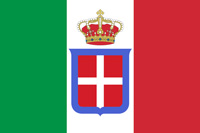World War I (1914-1918)

Ninth Battle of the Isonzo
The Ninth Battle of the Isonzo was an Italian offensive against Austria-Hungary in the course World War I. Including a triumvirate of battles launched after the Italians' successful seizure of Gorizia in August 1916 to extend their bridgehead to the left of the town, it ended in further failure for the Italian Chief of Staff Luigi Cadorna.
The battle started with an attack on Vrtojba and the northern and central areas of the Karst Plateau. With the ninth battle fought from 1–4 November 1916 the combined casualty total from the three linked battles proved sufficiently heavy to ensure that each attack was of short duration (each less than a week). The Italians The Kingdom of Italy was a state that existed from 1861, when Victor Emmanuel II of Sardinia was proclaimed King of Italy, until 1946. The state resulted from a decades-long process, the Risorgimento, of consolidating the different states of the Italian Peninsula into a single state. That process was influenced by the Savoy-led Kingdom of Sardinia, which can be considered Italy's legal predecessor state. suffered 75,000 casualties and the Austro-Hungarians 63,000.
The Kingdom of Italy was a state that existed from 1861, when Victor Emmanuel II of Sardinia was proclaimed King of Italy, until 1946. The state resulted from a decades-long process, the Risorgimento, of consolidating the different states of the Italian Peninsula into a single state. That process was influenced by the Savoy-led Kingdom of Sardinia, which can be considered Italy's legal predecessor state. suffered 75,000 casualties and the Austro-Hungarians 63,000.
As always along the Soča (Isonzo), the Austro-Hungarian Austria-Hungary, often referred to as the Austro-Hungarian Empire, the Dual Monarchy, or Austria, was a constitutional monarchy and great power in Central Europe between 1867 and 1918. Austria-Hungary was one of the Central Powers in World War I, which began with an Austro-Hungarian war declaration on the Kingdom of Serbia on 28 July 1914. Army's command of the mountainous terrain provided a formidable natural barrier to the Italians' attempts to achieve a breakthrough. Cadorna had intended to ensure such a breakthrough in the wake of the capture of Gorizia during the Sixth Battle of the Isonzo, but instead the war of attrition gathered pace.
Austria-Hungary, often referred to as the Austro-Hungarian Empire, the Dual Monarchy, or Austria, was a constitutional monarchy and great power in Central Europe between 1867 and 1918. Austria-Hungary was one of the Central Powers in World War I, which began with an Austro-Hungarian war declaration on the Kingdom of Serbia on 28 July 1914. Army's command of the mountainous terrain provided a formidable natural barrier to the Italians' attempts to achieve a breakthrough. Cadorna had intended to ensure such a breakthrough in the wake of the capture of Gorizia during the Sixth Battle of the Isonzo, but instead the war of attrition gathered pace.
Neither side could particularly afford the casualties suffered but the Austro-Hungarians in particular were finding their defensive lines increasingly stretched. Realising this they continued to call upon their German ally to provide military assistance within the sector. When the Germans The German Empire, also referred to as Imperial Germany, the Second Reich, as well as simply Germany, was the period of the German Reich from the unification of Germany in 1871 until the November Revolution in 1918, when the German Reich changed its form of government from a monarchy to a republic. During its 47 years of existence, the German Empire became the industrial, technological, and scientific giant of Europe. finally assented (sensing the potential collapse of the Austro-Hungarian position) and constructed a combined force in time for the Twelfth Battle of Isonzo, the results were dramatic.
The German Empire, also referred to as Imperial Germany, the Second Reich, as well as simply Germany, was the period of the German Reich from the unification of Germany in 1871 until the November Revolution in 1918, when the German Reich changed its form of government from a monarchy to a republic. During its 47 years of existence, the German Empire became the industrial, technological, and scientific giant of Europe. finally assented (sensing the potential collapse of the Austro-Hungarian position) and constructed a combined force in time for the Twelfth Battle of Isonzo, the results were dramatic.
However, with the ninth battle called off in failure on 4 November 1916 and the Italians undeniably weakened by continual offensive operations throughout the year - 1916 had seen five Isonzo operations on top of four undertaken the year before - a lengthy break was taken for the winter.
Operations renewed afresh with the Tenth Battle of the Isonzo on 12 May 1917.
HISTORY

RESOURCES
This article uses material from the Wikipedia articles "World War", "World War I", and "Ninth Battle of the Isonzo", which is released under the Creative Commons Attribution-Share-Alike License 3.0.
© Stories Preschool. All Rights Reserved.










